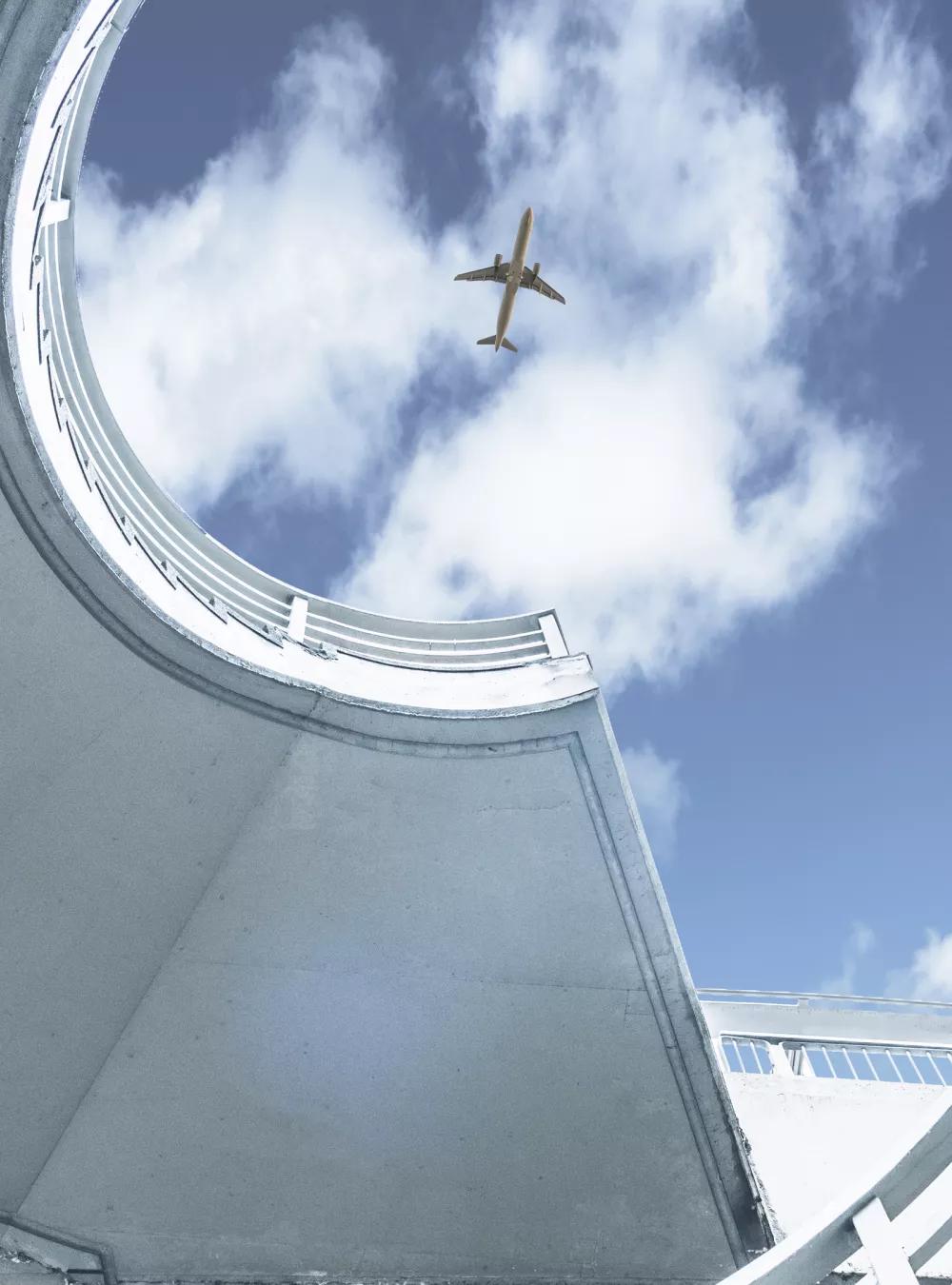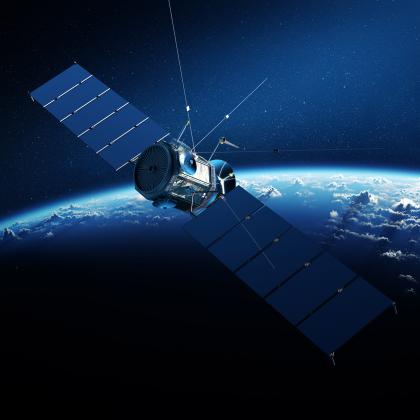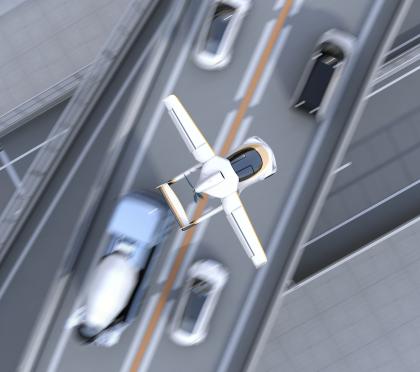The technological advances that have made real-time information exchange central to everyday life have the power to revolutionize aviation. That’s the FAA’s vision, and MITRE is accelerating its realization.

Digital-Age Innovations Shape the Future of Aviation
Our airspace is evolving daily. The launch of commercial space rockets is increasing. Drones are proliferating. And more changes are coming. Researchers are already working to develop air taxis for short-range transit in our cities. And solar-powered vehicles may soon fly in the airspace above traditional aircraft.
So, what will enable these vehicles—and more—to operate safely, efficiently, and equitably in the National Airspace System (NAS)?
The Federal Aviation Administration (FAA) believes ubiquitous information exchange will be key. That notion is at the heart of the FAA’s vision for the future of the NAS.
MITRE researchers are already engaged in multiple lines of research to make the vision a reality.
“The idea is to leverage technological developments and commercial infrastructures to enable all aviation stakeholders—from airspace users to those that manage them—to connect from anywhere at any time,” says Emily Stelzer, Ph.D., managing director of MITRE’s NAS Evolution and Systems Engineering division.
Both the FAA and MITRE believe the use of commercial infrastructures—such as wireless technologies, sensor networks, and communications satellite constellations—will add resiliency, cost-effectiveness, and flexibility to the current system. It will also enable the coordination needed to maintain high levels of safety and efficiency in an increasingly diverse system.
“Given the many changes that are occurring, achieving the vision will require interrelated advances on many fronts,” Stelzer says. “MITRE—as the operator of the FAA’s federal R&D center—is a key partner to the FAA on these efforts.”
Protecting Satellite Systems to Maintain Timing Accuracy

Many of the building blocks of the future NAS are already under development.
Foundational to the future airspace system is the Global Positioning System (GPS). Given aviation’s reliance on GPS for navigation, position, and timing information, maintaining its integrity is a must. MITRE is therefore working with the FAA and other U.S. government agencies to ensure that GPS signals are robust and resilient to attack.
“Our work has included the creation of a prototype tool that aviation stakeholders can use to see the health of GPS in near-real-time,” Stelzer says. “We also created a GPS signal spoofing detection solution that can operate on a cellphone.”
Additionally, we work with standards bodies to refine standards for GPS equipment for future aircraft.
Connecting Vehicles and Systems via Broadband
Another building block of the future vision is the connected aircraft concept, which MITRE is working with the FAA to achieve. While most aviation communications occur within an aviation-specific infrastructure today, the growth of commercial services for both traditional aviation stakeholders and new entrants provides an opportunity to improve the information exchange of tomorrow.
“By using these commercial services, it becomes possible to establish many more connections between systems and vehicles and enable faster information exchange,” Stelzer says. “Rather than relying primarily on air traffic control for information about things like turbulence, pilots might be able to access much of that information directly—whenever they need it.”
The idea is to enable all aviation stakeholders to connect from anywhere at any time.
Enhancing Information Exchange through Mobile Technologies
Connectivity and information exchange are not limited to commercial aviation. MITRE is exploring how mobile technologies such as tablets and smartphones can be used to support interconnectivity and data exchange with general aviation and business aviation operations.
For instance, our Digital Copilot is a mobile application developed to give solo pilots an automated second pair of eyes in the cockpit. We’ve also developed mobile apps for general aviation pilots to help prevent runway safety incidents and to improve departure time planning for business jet operators.
“We want the broadest possible adoption of these applications, so we’re making them available via license to industry for incorporation into their products—in keeping with our public service mission,” Stelzer notes.
In addition, MITRE is helping the FAA strengthen the cybersecurity of its existing systems.
“At our recommendation, the FAA is moving toward a zero-trust model,” Stelzer says.
Modernizing NAS Automation Development
We’re also working with the FAA to define a strategy that will help them move away from large monolithic automation systems.
“The plan we’re helping the FAA map out will help them take advantage of shared infrastructure elements and methodologies,” Stelzer explains. This will help optimize operating costs, enable the FAA to scale to meet dynamic user demands, and enhance data flows to improve air traffic management.
“We’ve already developed some of the main components of the plan—including the reference architecture and concept of use,” Stelzer says. “Now, we’re demonstrating that key capabilities within the FAA’s systems—such as time-based flow management—can be re-architected to meet the NAS’s performance and security needs.”
Integrating New Vehicle Types

To support the integration of drones, MITRE is conducting research at the state level to learn how these vehicles can be safely and efficiently accommodated in the NAS.
“Learnings from our state-level research efforts will support the maturation of UAS technology. That research will also inform national policy and FAA rulemaking to enable expanded UAS missions,” Stelzer notes.
Similar work is underway to accommodate futuristic advanced air mobility operations, which could include automated electric vehicles capable of vertical takeoff and landing that carry passengers and cargo short distances in urban areas (think: grabbing an air taxi from the airport to whisk you to your hotel).
Providing a Roadmap to the Next Level of Safety
In alignment with the key safety principles defined in the FAA’s vision, MITRE has released the Next Level of Safety approach for the NAS, a concept that combines the vast quantities of data produced by the information revolution with advanced analytics.
Under the Next Level of Safety approach, safety management shifts from the traditional single-organization focus to a 360-degree safety review that incorporates all stakeholders.
“This enables the community to discover better solutions than any one organization could achieve on its own,” Stelzer says.
In the envisioned future, artificial intelligence and machine learning (AI/ML)-based technologies would be used to monitor the system, identify risks, and generate timely safety intelligence.
Enhancing Standardization
We are also lending our expertise to both the FAA and the Civil Aviation Authority of Singapore to enhance flight information management worldwide.
One of the key components of this work is the standardization of data exchange requirements. “Our experts are contributing to the development of these standards, which will allow aviation stakeholders everywhere to share critical flight information more seamlessly,” Stelzer says.
“As all these efforts come to fruition, the future vision is destined to become a reality—and almost certain to influence aviation operations globally. It’s a new era in aviation, and we’re proud to be part of this exciting transformation.”
Join our community of innovators, learners, knowledge-sharers, and risk takers. View our Job Openings